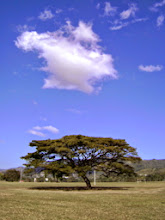I didn't realize that the Khmer Rouge regime only lasted three years, much like the Reign of Terror after the French Revolution. Like the Terror, they started off killing members of the old regime, then moved on to dissidents and intellectuals, and finally members of their own gang who weren't revolutionary enough. Before the Vietnamese invaded in 1978 there were more people getting carted to Choeung Ek in a day than they could get rid of.
The killing fields were just that, a place where they killed people, one by one, lining them up by the side of a pit, and knocking them over the head with something big and heavy and reuseable, like an ax or an axle, and then covering the resulting pile of bodies with chemicals to keep down the smell and finish off anyone who might not be quite dead. Simple and brutal.
 Now Choeung Ek is peaceful - chickens rustle around in the underbrush and you can hear a school playground nearby. There's a small museum but none of the original buildings are left. Instead there are hand painted signs around telling you what happened where. The english translations aren't very clear, but it's somehow a relief because it softens the blow a little. It takes you a minute or two to understand what happened, rather than being hit with it all at once.
Now Choeung Ek is peaceful - chickens rustle around in the underbrush and you can hear a school playground nearby. There's a small museum but none of the original buildings are left. Instead there are hand painted signs around telling you what happened where. The english translations aren't very clear, but it's somehow a relief because it softens the blow a little. It takes you a minute or two to understand what happened, rather than being hit with it all at once.If I remember right, there were around 160 pits found there, of which 86 have been excavated. The bones and clothes are on display in a large buddhist stupa in the middle. After heavy rain more bones and clothes rise to the surface and get put aside too. Outside the fence there are kids asking you for money. It's a little surreal.
 People were sent to Choeung Ek from Tuol Sleng, where I went next. It used to be a school, and I was impressed by how easily schools can be transformed into prisons. The building is falling apart now. A lot of the rooms are as they were, with maybe a picture on the wall to show how it was found - usually showing the last victim. Some of the rooms were essentially unchanged, but others were divided up into small individual cells.
People were sent to Choeung Ek from Tuol Sleng, where I went next. It used to be a school, and I was impressed by how easily schools can be transformed into prisons. The building is falling apart now. A lot of the rooms are as they were, with maybe a picture on the wall to show how it was found - usually showing the last victim. Some of the rooms were essentially unchanged, but others were divided up into small individual cells.The Khmer Rouge apparently kept very thorough records of all their victims, and the most powerful part of the museum is the section of photos. There are few captions, and many of them are only in Khmer, so I didn't understand a lot of it. I think some were members of the Khmer Rouge - generally young, some of them smiling, without numbers. Most are pictures of the soon-to-be victims. There are hundreds of them, and it was the sense of individual personality in each of them that struck me most. Some looked scared, some looked defiant. One man had a calm smile.
Most of them had simple laminated numbers, but one area showed people with a plastic information card, like in a mugshot. The writing was in Khmer, but they also had dates, I assume the date of their arrest. The ones shown were all in 1978, and many of them in February. I looked at them for quite a while. There were 4 on the 14th and 3 on the 15th, a few on the 17th and 18th. None on the 16th though. That was the day I turned 4.












 Our guides were great though, pictured having a well deserved
Our guides were great though, pictured having a well deserved 










